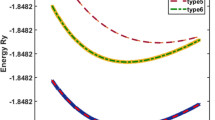Abstract
By the Tersoff potential based molecular dynamics (MD) method, the melting and axial compression of the (5,5) C, SiC, and Si nanotubes are simulated, and their molecular configurations, atomic radial distribution functions (RDF) and energy changes during heating-up, as well as their compressive force–strain curves, are obtained. According to the computed results, the differences of the melting and compressive mechanical properties of the three nanotubes are discussed. It is found that the melting C, SiC, and Si nanotubes have netlike, loose spherical and compact spherical configurations respectively, and that the C nanotube has the highest melting point, specific heat, melting heat and load support capability, whereas the Si nanotube has the lowest ones.








Similar content being viewed by others
Change history
14 February 2019
The Editor-in-Chief has retracted this article.
14 February 2019
The Editor-in-Chief has retracted this article.
14 February 2019
The Editor-in-Chief has retracted this article.
References
Iijima SH (1991) Nature 354(6348):56
Dai HJ, Hafner JH, Rinzler AG, Colbert DT, Smalley RE (1996) Nature 384(6605):147
Shen H, Mu X (2005) J Mater Sci Eng 23(3):321
Dmitrii FP, Federico R (2006) Small 2(1):22
Seifert G, Köhler Th, Urbassek HM, Hernández E, Frauenheim Th (2001) Phys Rev B 63:193409
Tang YH, Pei LZ, Chen YW, Guo C (2005) Phys Rev Lett 95:116102
Durgun E, Tongay S, Ciraci S (2005) Phys Rev B 72:75420
Durgun E, Tongay S, Ciraci S (2005) Turk J Phys 29:307
Jaeil B, Zeng XC, Hideki T, Zeng JY (2004) Chemistry 101(9):2664
Shen H (2004) Comput Appl Chem 21(3):485
Young-Kyun K, Savas B, David T (2004) Phys Rev Lett 92:15901
Yeau-Ren J, Ping-Chi T (2005) J Chem Phys 122:224713
Madhu M, Ernst R (2004) Phys Rev B 69:115322
Fletcher R, Reeves C (1964) Comput J 7:149
Tersoff J (1998) Phys Rev Lett 56(6):632
Tersoff J (1988) Phys Rev Lett 61:2879
Sekkai W, Zaoui A (2002) New J Phys 4:91
Tersoff J (1989) Phys Rev B 39(8):5566
Leach AR (1996) Molecular modeling. Addison Wesley Longman Limited, pp 316–317
Seong GK, David T (1999) Phys Rev Lett 72:2418
Nose S (1984) J Chem Phys 81(1):511
Shen H (2006) Chinese J Mater Res 20(1):93
Wang L, Hu H (2004) Acta Mech Solida Sinica 25(3):233
Acknowledgement
The paper is supported by the NUAA Innovation Fund.
Author information
Authors and Affiliations
Corresponding author
Additional information
The Editor-in-Chief has retracted this article (1) because it has been previously published by the same author in a Chinese-language journal (2). Some additional text is included in the English version of the article, but most of the text and all the figures are the same as in the article that was written in Chinese. The Chinese-language publication was not cited in the duplicate publication. The author apologizes for any inconvenience caused. The author agreed to this retraction.
1. Shen HJ (2007) MD simulations on the melting and compression of C, SiC and Si nanotubes. J Mater Sci 42: 6382-6387.https://doi.org/10.1007/s10853-006-1205-2
2. Shen HJ (2006) MD studies on the melting and compressive properties of C, SiC and Si nanotube (in Chinese). J Mater Sci Eng 24: 679–682.
About this article
Cite this article
Shen, H. RETRACTED ARTICLE: MD simulations on the melting and compression of C, SiC and Si nanotubes. J Mater Sci 42, 6382–6387 (2007). https://doi.org/10.1007/s10853-006-1205-2
Received:
Accepted:
Published:
Issue Date:
DOI: https://doi.org/10.1007/s10853-006-1205-2




